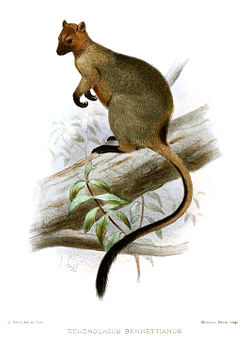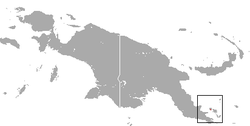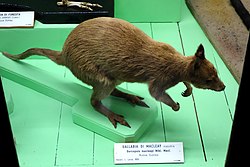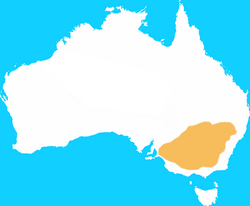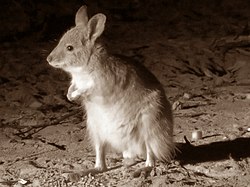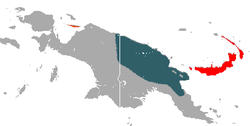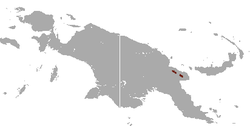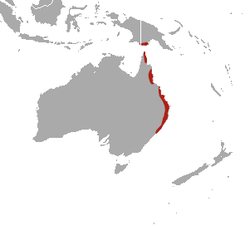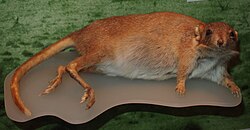Top Qs
Timeline
Chat
Perspective
List of macropodiformes
Species in mammal suborder Macropodiformes From Wikipedia, the free encyclopedia
Remove ads
Macropodiformes is a suborder of Australian marsupial mammals. Members of this suborder are called macropodiformes, and include kangaroos, wallabies, bettongs, potoroos, and rat-kangaroos. Macropodiformes is one of three suborders that form the order Diprotodontia, the largest extant order of marsupials. They are found in Australia and New Guinea, generally in forests, shrublands, grasslands, and savannas, though some species can also be found in deserts and rocky areas. They range in size from the musky rat-kangaroo, at 20 cm (8 in) plus a 6 cm (2 in) tail, to the red kangaroo, at 160 cm (63 in) plus a 120 cm (47 in) tail. Macropodiformes primarily eat leaves, grass, ferns, and shrubs, as well as fruit and other plant material.
Many macropodiformes do not have population estimates, but the ones that do range from 40 individuals to 500,000. Ten species are categorized as endangered: Calaby's pademelon, Cape York rock-wallaby, dingiso, Goodfellow's tree-kangaroo, ifola, Matschie's tree-kangaroo, mountain pademelon, nabarlek, northern bettong, and Proserpine rock-wallaby. A further six species are categorized as critically endangered: the black dorcopsis, Gilbert's potoroo, golden-mantled tree-kangaroo, tenkile, Wondiwoi tree-kangaroo, and woylie. Eight species have gone extinct in the modern era, all between the 1880s and the 1940s after the colonization of Australia began: the broad-faced potoroo, crescent nail-tail wallaby, desert bettong, desert rat-kangaroo, eastern hare-wallaby, Lake Mackay hare-wallaby, Nullarbor dwarf bettong, and toolache wallaby.
The seventy-two extant species of Macropodiformes are divided into three families: Hypsiprymnodontidae, containing a single species, the musky rat-kangaroo; Macropodidae, containing sixty-three species divided between the twelve genera in the subfamily Macropodinae and the single genus of the subfamily Sthenurinae; and Potoroidae, containing eight species in three extant genera. Dozens of extinct Macropodiformes species have been discovered, though due to ongoing research and discoveries the exact number and categorization is not fixed.[1]
Remove ads
Conventions
The author citation for the species or genus is given after the scientific name; parentheses around the author citation indicate that this was not the original taxonomic placement. Conservation status codes listed follow the International Union for Conservation of Nature (IUCN) Red List of Threatened Species. Range maps are provided wherever possible; if a range map is not available, a description of the macropodiformes's range is provided. Ranges are based on the IUCN Red List for that species unless otherwise noted. All extinct genera, species, or subspecies listed alongside extant species went extinct after 1500 CE, and are indicated by a dagger symbol "†".
Remove ads
Classification
Summarize
Perspective
The suborder Macropodiformes consists of three extant families: Hypsiprymnodontidae, Macropodidae, and Potoroidae. Hypsiprymnodontidae contains a single species and Potoroidae contains eight species in three extant genera. Macropodidae is divided into two subfamilies: Macropodinae, containing sixty-three species divided between twelve genera, and Sthenurinae, containing a single species. In addition to the extant species, eight species—four in Macropodidae and four in Potoroidae, including one extinct genus—have gone extinct in the modern era, all between the 1880s and the 1940s after the colonization of Australia began.
Family Hypsiprymnodontidae
- Genus Hypsiprymnodon (musky rat-kangaroo): one species
Family Macropodidae
- Subfamily Macropodinae
- Genus Dendrolagus (tree-kangaroos): fourteen species
- Genus Dorcopsis (dorcopsises): four species
- Genus Dorcopsulus (forest wallabies): two species
- Genus Lagorchestes (hare-wallabies): four species (two extinct)
- Genus Macropus (grey kangaroos): two species
- Genus Notamacropus (wallabies): eight species (one extinct)
- Genus Osphranter (kangaroos): four species
- Genus Onychogalea (nail-tail wallabies): three species (one extinct)
- Genus Petrogale (rock-wallabies): sixteen species
- Genus Setonix (quokka): one species
- Genus Thylogale (pademelon): seven species
- Genus Wallabia (swamp wallaby): one species
- Subfamily Sthenurinae
- Genus Lagostrophus (banded hare-wallaby): one species
Family Potoroidae
- Genus Aepyprymnus (rufous rat-kangaroo): one species
- Genus Bettongia (bettongs): six species (two extinct)
- Genus Caloprymnus† (desert rat-kangaroo): one species (one extinct)
- Genus Potorous (potoroos): four species (one extinct)
Remove ads
Macropodiformes
Summarize
Perspective
The following classification is based on the taxonomy described by the reference work Mammal Species of the World (2005), with augmentation by generally accepted proposals made since using molecular phylogenetic analysis, as supported by both the IUCN and the American Society of Mammalogists.[4]
Hypsiprymnodontidae
Macropodidae
Subfamily Macropodinae
Subfamily Sthenurinae
Potoroidae
Remove ads
References
Sources
Wikiwand - on
Seamless Wikipedia browsing. On steroids.
Remove ads


